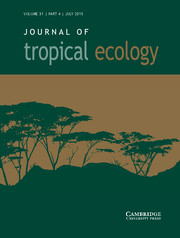No CrossRef data available.
Article contents
Beetle rhythms in the rain: time series analysis and seasonal activity patterns of sympatric large-sized Goliathinae in Uganda’s forests
Published online by Cambridge University Press: 06 November 2025
Abstract
In tropical forests, the relative thermal and climatic stability contrasts with the seasonal oscillations, mainly due to rainfall patterns, that structure life cycles in temperate zones, leading to different ecological strategies among species. This study investigates the seasonal activity patterns and size-abundance relationships of four sympatric Goliath beetle species (Goliathus goliatus, Mecynorhina confluens, Mecynorrhinella poggei, and Fornasinius russus) in the Mabira Forest Reserve and in other forest areas, Uganda. Over three years (2021–2023), 1,231 individuals were sampled monthly using standardised traps and random transects. Time series analyses were used to explore patterns of abundance. We found a significant negative correlation between body size and abundance (r = –0.78, P < 0.05), with the smaller species, M. confluens and F. russus, being most numerous. Time series and Analysis of Variance (ANOVA) revealed significant sinusoidal patterns of seasonality for G. goliatus, M. poggei, and F. russus, while M. confluens showed non-significant cyclical trends, indicating potential stochastic fluctuations or greater ecological flexibility. Seasonal peaks were species-specific and generally occurred during transitional periods between wet and dry seasons, diverging from previously reported insect patterns peaking during the wet season. These findings suggest that differing phenological strategies may facilitate coexistence and niche partitioning, particularly among species differing in body size. Furthermore, larger species appeared to emerge earlier in the year, possibly reflecting life history adaptations or competitive dynamics. Our study highlights the importance of long-term, species-specific monitoring to understand ecological roles and vulnerabilities of tropical beetles, especially large-bodied taxa increasingly threatened by habitat loss and climate variability. Such insights are essential for informing conservation strategies in biodiverse tropical ecosystems.
Information
- Type
- Research Article
- Information
- Copyright
- © The Author(s), 2025. Published by Cambridge University Press


